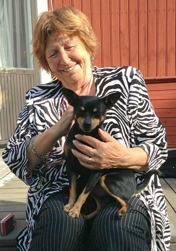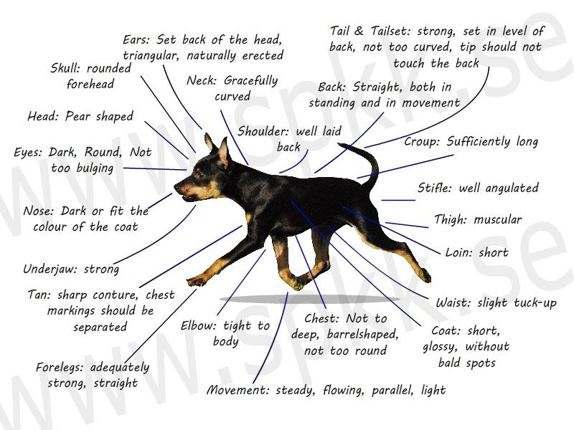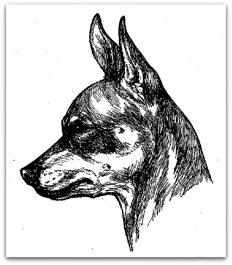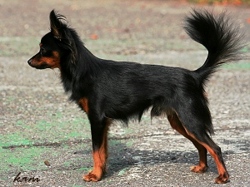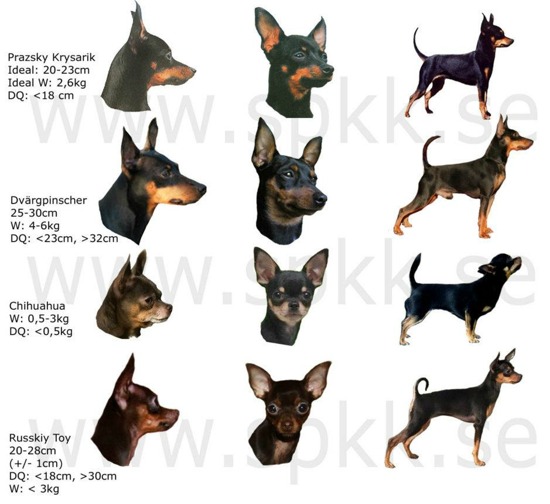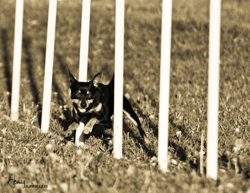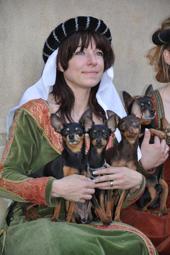About Pražský Krysařík
Pražský Krysařík was actually the first dog I have been in contact with. My parents are from the Czech Republic and since I was 2 years old I have visited relatives every year. I have always been in contact with the breed since you could see them running freely on the streets.
In 1993 my grandmother bouth me a brown and tan little PK bitch. Unfortunatly back then the Czech Republic wasn´t part of the EU and it was hard to import/export dogs. So she stayed there with a relative to us - she died in 2007, 14 years old.
The goal with my breeding on Pražský Krysařík is to breed on healthy dogs that like to work and have nice temperaments. The Pražský Krysařík is known for it´s good temperament and I like to keep it that way! Dogs that really can catch a rat (not be eaten by it) and then also win at shows! An typical PK in other words!
This breed (or any other for that matter) is not a accessory or something to keep in your handbag. This is a very active breed that loves to please. At the same time it is a very convenient breed that is easy to handle.
If you compare the Pražský Krysařík with other breeds in the same size you will see that they are superior when it comes to perceptive, eager to please and speed!
The breed is fit to train and compete in many different sports such as Agility, Rally obedience, Obedience, Freestyle, Lure-coursing and Tracking!
In the picture - Emilie Kopečková with Rocky, one of the first to own a Prazky Krysarik and also the founder of KPPPK (Czech Prazsky Krysarik Club). That we had the great pleasure of having here in Sweden for a visit in summer 2013 & 2014. She is the one who recomended us to buy Rocky & I´m so thankfull for that!!
 Ing. Jan Kubeš - vice precident, Renata & MVDr. Lubomír Široký- President of CMKU, Czech Kennel Club
Ing. Jan Kubeš - vice precident, Renata & MVDr. Lubomír Široký- President of CMKU, Czech Kennel Club
The recent years I have seen a drastic development of this breed where the size & color is the focal point just because the breeders sell more "handbags"...
The Pražský Krysařík has gone from a sturdy but in the same time elegant dog to a miniature rat that consist of only skin and bone, that dosn´t even walk properly in the show ring!
It is a dangerous development that has gone very fast and already to far!
The breeding base has taken a beating and it feels like money has controlled the breeds faith and that´s why I´m gonna do everything in my power to try and retain the original Pražský Krysařík that I grew up with!
Appearance
The dog's coat consists of short, glossy hair and the most common color is black and tan, which is also the original color. Lately, other colors have been approved: Brown and tan, Blue and tan, Lila and tan, Yellow, Red and Merle. (But if you ask me a Prazsky Krysarik will NEVER be other then shorthaired, black or brown & tan...) A PK is 2 cm shorter in maximum height than the minimum height of the Miniature Pinscher. Ideal height is 23 cm. Adult weight is mostly between 1,5 kg to 3,2 kg. Generally the best weight is 2,6 kg.
The breed matures late in appearance, they become much stronger over the years. They should not look skinny or thin, rather in the opposite direction, yet with a certain elegance.
Black & tan Brown & tan Mearle Blue & tan Red Yellow
(Click to enlarge)
Areas of Use
Prazsky krysarik might be small, but is nevertheless a very nice dog to work with. Agility, freestyle, obedience, tracking etc. The sense of smell is highly developed, and prazsky krysarik is still a great rathunter, just as the original purpose was. They have a high prey drive and will readily go after, squirrels, rats, mice and raccoons.
Life expectancy
The Prazsky krysarik has a life span of 12 to 14 years.
History
It used to grace the royal palaces in the Middle Ages. It was later used as rat catchers by commoners. It has been a breed since before the Polish king Boleslav II The Brave (1058–1080). He became fond of the Ratter. He had two and they came from Bohemia (the Czech lands). It is said that the Prague Ratter started to lose favor in the 19th century as the Miniature Pinscher became more prevalent. The breed started to experience a renaissance in the 1980s as Czechs and Slovaks started to breed them again.


